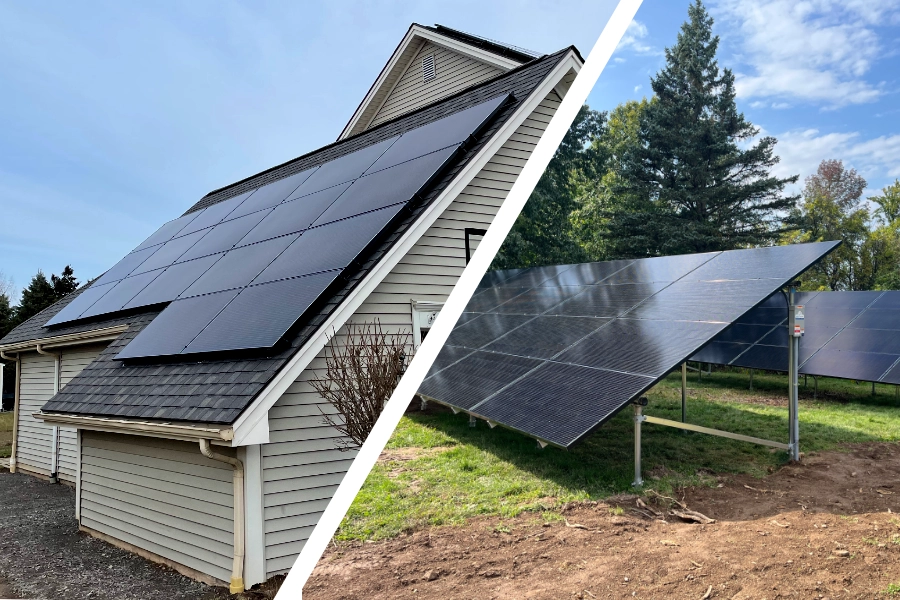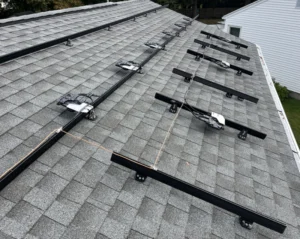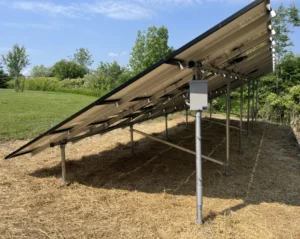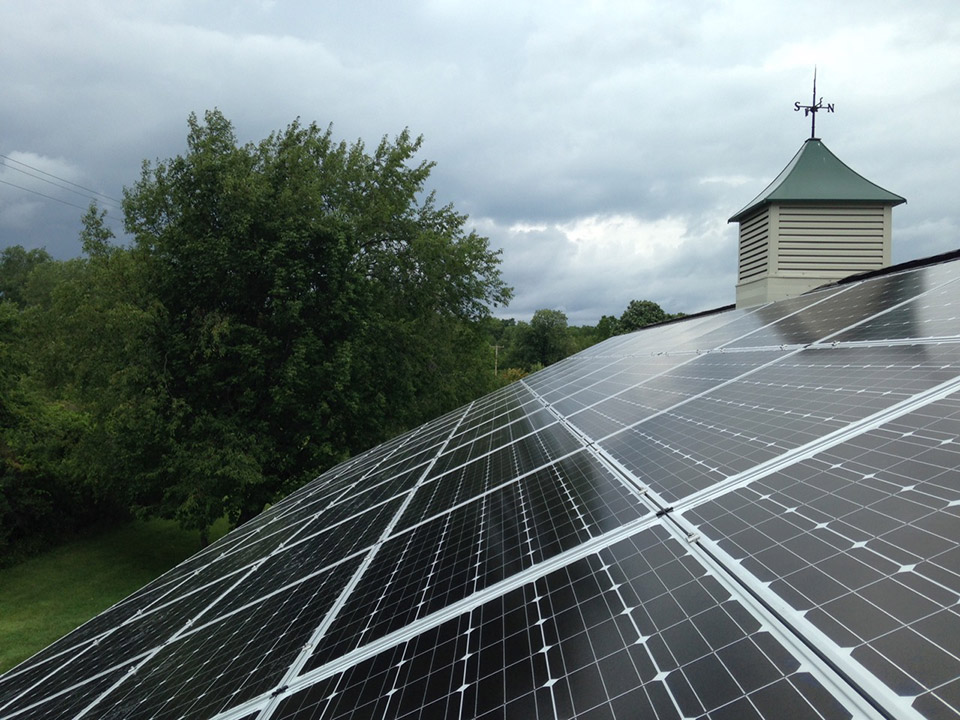
Roof Mounted Vs Ground Mounted:
Pros and Cons
Installing solar panels is a great investment, but it is important to chose a solar system that meets the needs of your home.
The two most common types of solar system are ground mounted and roof mounted systems. Both types have their own advantages and disadvantages, so it comes down to determining which best suits your installation goals.
While there are other options available such as pole mounts or solar shingles, they offer less value (and a longer payback period) for the average residential customer.
What are Ground / Roof Mounts?
Roof Mounted systems are attached directly to, and supported by, the roof of your house, barn or other structure. Flat, sloped, asphalt, metal – many different types of roof can support a solar system, though the way it is attached will vary. Most systems require penetration to connect the racking, which holds the panels in place, securely to the rooftop.
Ground Mounted systems have panels are supported by a standalone metal frame that is secured to the ground with large metal screws or concrete foundations. Creating a new structure, rather than relying on an existing one, to support panels means there is much more flexibility for location, orientation and array size.
Roof Mounts: Pros and Cons
Pros of a Roof Mount
Less material costs than ground mounted systems
The panels are mainly supported by an existing structure, using less metal than a ground mount which requires building a support system from scratch. Ground mounts also require the use of long strands of large wire to bring power from the array to the house with minimal loss.
Potential lower labor costs
Typically, roof mounted systems are less labor intensive than ground mounts. This is because the panel support system does not need to be built from scratch and the wiring does not have to travel as far to reach the main service panel.
There are, however, some roof conditions, such as being very steep, that can make installations more challenging and costly. Check the article on Solar Cost Considerations for more details.
Only uses unusable space
Ground mounted solar arrays take up yard space that could be used for recreation, agriculture or other purposes. For example, a 20-panel 12kW ground mount needs 600 square feet for the frame alone.
Protects roof from exposure
The area beneath the panels are protected from UV rays and also weather damage from snow, ice, hail as well as debris. The panels themselves are built to stand up to extreme weather and are more durable than asphalt shingles
Cannot be accessed by unauthorized visitors
Being easily accessible makes ground mounts vulnerable to damage from vandalism, wildlife, vehicles or other ground-level hazards.
Cons of a Roof Mount
- Adds significant weight to the roof
- Makes roof replacement difficult
- Usually requires penetration of the roof
- Size of the solar is limited to the available space
- Less than ideal orientation
- Harder to maintenance
Summary
Low material costs and easy installation make roof mounts are the most cost effective option for installing solar in most situations. However, relying on an existing structure means that the solar array is confined to the size, location and direction of the existing roof. This can limit the maximum production and efficiency of the system, potentially making it difficult to completely cover a homes energy needs.
Being above ground level protects roof mounts from vandalism, accidental collision and debris. On the flip side being difficult to access makes maintenance, both repair and array cleaning, more difficult.
A well engineered and installed system should not compromise the integrity of the existing roof, and could even potentially extend it’s lifespan. However improper installation or failure to account for the weight of the system as well as snow and wind loads could lead to serious damages. That is why it is very important to find a trustworthy installer with a workmanship guarantee!
Ground Mount: Pros and Cons
Pros of a Ground Mount
Easier maintenance
Ground mounted solar arrays are easily accessible for both maintenance and cleaning. This is especially convenient for a northern climate where snow that could potentially build up and limit solar production can be conveniently brushed away.
Flexible placement
Being a standalone structure means ground mounted arrays are free to be placed anywhere on the property. This allows can be beneficial for both functionality – avoiding trees and other sources of shade – and for aesthetics. The only restriction is that placing the array more than 200 feet from the house requires running larger, more expensive wire.
Higher energy production
The flexibility of ground mount placement not only helps avoid sources of shade such as trees, but also to match the ideal orientation to catch the most annual sunlight. For New York this means facing the panels true south. Any roof that does not have an un-shaded, southern-facing plane will fail to produce as much electricity as an identically sized ground mount.
No size restrictions
The size of roof mounts are limited by the amount of open, un-shaded, properly oriented space. This amount is further reduced by the need for fire safety and ventilation setbacks. Ground mounts, meanwhile, can be built to any size needed to match the property’s electrical use.
Does not require roof work
While a well installed rooftop solar should have no issues, there are always risk factors due to the added weight and roof penetrations. Adding solar to a roof could also void any warranties on the roof or it’s components.
Additionally, having solar panels increases the cost of roof replacement. With solar panel warranties typically lasting 25 years, installing solar on an older roof means going through at least two expensive replacements during the lifetime of the system.
Installing ground mounts eliminates all roof related concerns!
Cons of a Ground Mount
- Higher installation and material costs
- Easier access for vandals or debris
- Limits use of land
Summary
Flexible panel placement makes it so ground mounted arrays will almost always produce more energy per panel than roof mounted arrays. However, building a new structure to support panels means a much higher material cost.
Higher energy production combined with the lack of size restrictions imposed by roof planes, make ground mounts a great option for those with a high electrical use. Large ground mounted arrays take up a lot of yard space that could have other uses.
Ground mounts are easily accessed for cleaning and maintenance, but also for vandalism and other potential damages.
Should I Choose a Roof Mount or Ground Mount?
This is a difficult question to provide a blanket answer to. There are many factors that can affect the cost, efficiency and viability of either type of solar at your home.
The easiest way to determine which system is right for you would be to talk with a knowledgeable solar sales representative or designer. They can survey your property and walk you through possible designs to meet your energy goals and cost restrictions.
But for the most simplistic comparison:
Roof Mounts are a good choice for:
- Urban/ Suburban homes or others who need to conserve space
- People looking to save the most money
- Those with a suitable roof (newer, southern facing, lots of open space, ect)
- Homes with low energy usage
Ground Mounts are a good choice for:
- Rural properties, or those with a lot of land,
- Those with unsuitable roofs (older, smaller, many obstructions, shaded ect.)
- Homes with high energy demands









